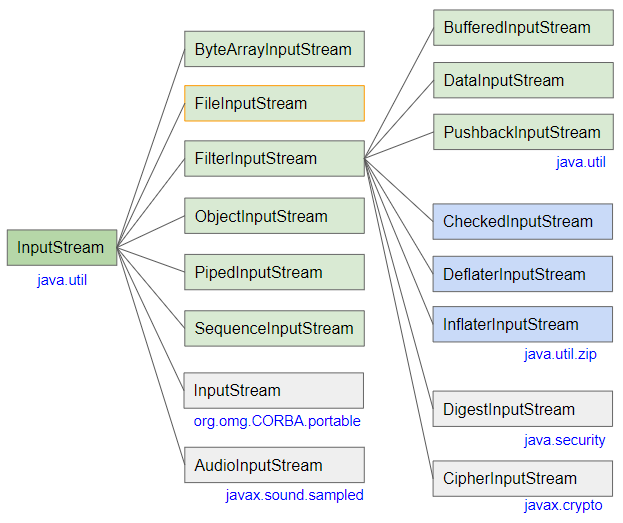Die Anleitung zu Java FileInputStream
1. FileInputStream
FileInputStream ist eine Unterklasse von InputStream, mit der Binärdateien wie Fotos, Musik, Videos gelesen werden. Die empfangene Daten des Lesens sind rohe bytes (raw bytes). Für normale Textdateien sollten Sie stattdessen FileReader verwenden.
public class FileInputStream extends InputStream
- InputStream
- ByteArrayInputStream
- PushbackInputStream
- PipedInputStream
- SequenceInputStream
- BufferedInputStream
- DataInputStream
- FilterInputStream
- ObjectInputStream
- AudioInputStream
- InflaterInputStream
- DigestInputStream
- DeflaterInputStream
- CipherInputStream
- CheckedInputStream
FileInputStream constructors
FileInputStream(File file)
FileInputStream(FileDescriptor fdObj)
FileInputStream(String name)Die meisten Methoden von FileInputStream werden von InputStream geerbt:
public final FileDescriptor getFD() throws IOException
public FileChannel getChannel()
// Methods inherited from InputStream:
public int read() throws IOException
public int read(byte b[]) throws IOException
public int read(byte b[], int off, int len) throws IOException
public byte[] readAllBytes() throws IOException
public byte[] readNBytes(int len) throws IOException
public int readNBytes(byte[] b, int off, int len) throws IOException
public long skip(long n) throws IOException
public int available() throws IOException
public synchronized void mark(int readlimit)
public boolean markSupported()
public synchronized void reset() throws IOException
public void close() throws IOException
public long transferTo(OutputStream out) throws IOExceptionFileChannel getChannel() | Es wird verwendet, um das eindeutige Objekt FileChannel zurückzugeben, das diesem FileInputStrem verbunden ist. |
FileDescriptor getFD() | Es wird verwendet, um ein Objekt FileDescriptor zurückzugeben. |
2. Example 1
Als erstes Beispiel verwenden wir FileInputStream um eine mit UTF-8 codierte japansiche Textdatei zu lesen:
utf8-file-without-bom.txt
JP日本-八洲Hinweis: UTF-8 verwendet 1, 2, 3 oder 4 bytes zum Speichern eines Zeichen. Inzwischen liest FileInputStream jedes byte aus der Datei, deshalb Sie ein ziemlich fremdes Ergebnis erhalten.

FileInputStreamEx1.java
package org.o7planning.fileinputstream.ex;
import java.io.File;
import java.io.FileInputStream;
import java.io.IOException;
import java.net.MalformedURLException;
public class FileInputStreamEx1 {
public static void main(String[] args) throws MalformedURLException, IOException {
// Windows Path: C:/Data/test/utf8-file-without-bom.txt
String path = "/Volumes/Data/test/utf8-file-without-bom.txt";
File file = new File(path);
FileInputStream fis = new FileInputStream(file);
int code;
while((code = fis.read()) != -1) {
char ch = (char) code;
System.out.println(code + " " + ch);
}
fis.close();
}
}Output:
74 J
80 P
230 æ
151
165 ¥
230 æ
156
172 ¬
45 -
229 å
133
171 «
230 æ
180 ´
178 ²Um die Textdateien UTF-8, UTF-16,.. zu lesen, sollten Sie FileReader oder InputStreamReader verwenden:
Die Anleitungen Java IO
- Die Anleitung zu Java CharArrayWriter
- Die Anleitung zu Java FilterReader
- Die Anleitung zu Java FilterWriter
- Die Anleitung zu Java PrintStream
- Die Anleitung zu Java BufferedReader
- Die Anleitung zu Java BufferedWriter
- Die Anleitung zu Java StringReader
- Die Anleitung zu Java StringWriter
- Die Anleitung zu Java PipedReader
- Die Anleitung zu Java LineNumberReader
- Die Anleitung zu Java PushbackReader
- Die Anleitung zu Java PrintWriter
- Die Anleitung zu Java IO Binary Streams
- Die Anleitung zu Java IO Character Streams
- Die Anleitung zu Java BufferedOutputStream
- Die Anleitung zu Java ByteArrayOutputStream
- Die Anleitung zu Java DataOutputStream
- Die Anleitung zu Java PipedInputStream
- Die Anleitung zu Java OutputStream
- Die Anleitung zu Java ObjectOutputStream
- Die Anleitung zu Java PushbackInputStream
- Die Anleitung zu Java SequenceInputStream
- Die Anleitung zu Java BufferedInputStream
- Die Anleitung zu Java Reader
- Die Anleitung zu Java Writer
- Die Anleitung zu Java FileReader
- Die Anleitung zu Java FileWriter
- Die Anleitung zu Java CharArrayReader
- Die Anleitung zu Java ByteArrayInputStream
- Die Anleitung zu Java DataInputStream
- Die Anleitung zu Java ObjectInputStream
- Die Anleitung zu Java InputStreamReader
- Die Anleitung zu Java OutputStreamWriter
- Die Anleitung zu Java InputStream
- Die Anleitung zu Java FileInputStream
Show More
- Anleitungen Java Servlet/JSP
- Die Anleitungen Java New IO
- Anleitungen Spring Cloud
- Die Anleitungen Oracle Java ADF
- Die Anleitungen Java Collections Framework
- Java Grundlagen
- Die Anleitungen Java Date Time
- Java Open Source Bibliotheken
- Anleitungen Java Web Services
- Die Anleitungen Struts2 Framework
- Anleitungen Spring Boot